Written for Timetravelrome by Michel Gybels
History of Carthago Nova
Originally named Martia, this settlement on the southern Iberian coast was refounded by the Carthaginian general Hasdrubal Barca (Hannibal’s brother) around 227 BC as Qart Hadasht (the “New City”). Its time as a Carthaginian possession was short-lived. Just seventeen years later, as the Second Punic War was drawing to a close, the Roman general Scipio Africanus took the city, using it as a military stronghold.
No doubt on account of its proximity to Spain’s vital silver mines, Carthago Nova prospered throughout the mid to late Republic: the historian Polybius describing it as a magnificent capital resplendent in palaces, temples, and, of course, its all important harbour. Indeed, the city’s remarkable natural harbour—one of the finest in the Roman world—didn’t just benefit the Romans strategically. It also yielded some of the best garum (a fish sauce used in all types of Roman cooking) in the entire Roman Empire.
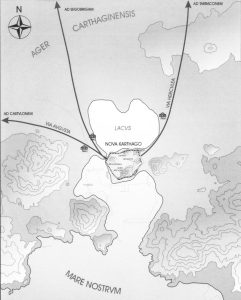
Geographical location of Carthago Nova. Source: “Carthago Nova : la ville et le territoire. Recherches récentes”.
The granting of colonial status (Urbs Iulia Nova Carthago) in the year 54 BC marked the beginning of an intense process of urban development which culminated in the reign of Augustus (63 BC to 14 AD). This was when the new elites, made rich by trade and mining, brought about important developments within the city, with a new urban street network in which the streets formed blocks or insulae. In this period some of the most important buildings of the 1st century appeared, the ultimate goal of the transformation being to design a city in the image and likeness of the capital of the empire.
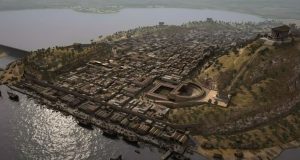
Panoramic view of the ancient Carthago Nova. Source: regmurcia.com
Carthago Nova also played a vital role in the civil war known as “The Year of the Four Emperors” in 69 AD. It was the seat of Galba, Spain’s governor, who was the first to respond to Julius Vindex’s call to free humanity from the Emperor Nero. Galba made his way from Carthago Nova to Rome, where he briefly ruled as emperor before being assassinated at the request of his rival, Otho. Under Diocletian in 298 AD, the city was renamed Carthaginesis and made the provincial capital of Hispania, and in 550 the Byzantine Emperor Justinian named it the capital of Spania (despite the fact it was under the Visigoths).
Roman Monuments of Cartagena
Cartagena has no shortage of Roman remains. Many have become interpolated either within or on the face of its subsequent buildings. However, there are plenty of well preserved independent sites too: the Augusteum (a college for the imperial cult) sits in the heart of the historical center alongside the remains of the Roman Forum and the Casa de la Fortuna—arguably one of the best examples of a luxury Roman villa in existence. The main Roman landmark is the amphitheater: a wonderful architectural feat dating from 5 – 1 BC to which the city’s archaeological museum is attached. Just on the outskirts of the historical center is the Torre Ciega: a monument dating from the first century BC that formed part of an enormous Roman necropolis.
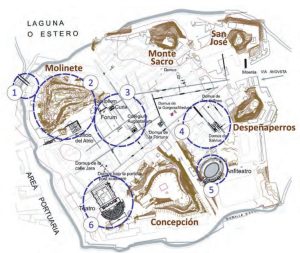
Main archaeological areas in Cartagena. Source: “Cartagena City in the early roman empire era. Generation and analysis of a digital elevation model.”
The Molinete Roman Forum Museum
The museum allows you to dive into the history of the Cerro del Molinete from the 19th and 20th centuries back to the Old Carthago Nova. Over its three floors a selection of the most significant pieces found in the excavations around the Forum is exhibited, among with the paintings of Apollo and the Muses, the horn of plenty or the painting of a hunter are of particular interest.
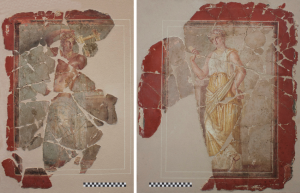
Apollo and Muse Calliope, found in the Atrium Building. Source: “La pittura romana in Spagna: questioni di metodo e prospettive di ricerca“
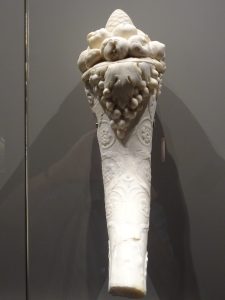
Horn of abundance displayed in the Museum. Photo by Michel Gybels.
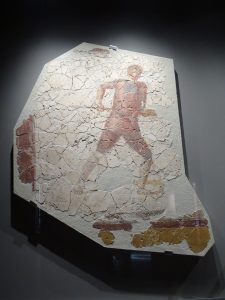
Fresco with a hunter. Photo by Michel Gybels.
As early as the 2nd century BC the Cerro del Molinete (Arx Hasdrubalis) was organised into terraces with public and private buildings. At its top stood the walls that defended the city and the temple. With urban renewal in the 1st century BC, several rectangular blocks were laid out at the foot of the hill.
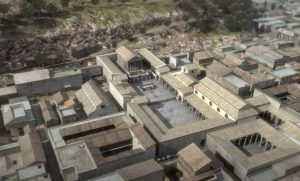
Reconstruction of the Forum of Carthago Nova. Source: regmurcia.com
What we now call the Roman Forum Quarter was built on these blocks which consisted of a thermal complex with a wide arcaded square, the Atrium Building for holding religious banquets, the Sanctuary of Isis and the neuralgic center, the Colonial Forum with the most important religious, political and administrative buildings among which the Curia or local senate was of particular note. The blocks of Molinete were delimited by decumanus and by cardo (north-south streets).
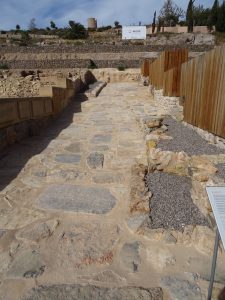
A section of the Cardo – the north-south street. Photo by Michel Gybels.
The Colonial Forum and the Curia
The Colonial Forum stood at the foot of the acropolis located on the Cerro del Molinete, a short distance from the port. Its monumental buildings would be from the 1st century AD, within a domestic and artisan neighborhood of the 2nd and 1st centuries BC, whose buildings were abandoned and destroyed. The square and its buildings were the scene of the Imperial cult ceremonies and processions on the occasion of state holidays, the center of the city’s political and administrative life and a privileged space for tributes to the Imperial House, patrons and local notables.
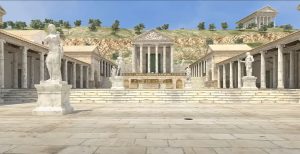
Screen capture from the video about the Roman Forum of Cartagena. Source: regmurcia.com
It was organised in a large rectangular square over three terraces. On the upper terrace a temple dedicated to Augustus was built, it dominated the whole complex, emphasising the power of the sacred over the political, judicial and administrative sphere. The middle terrace was flanked by the Curia and communicated with the upper one through side stairs. At its head was a large altar or podium perhaps for tributes to the colony. The lower terrace, the largest, must have been flanked by buildings such as the basilica, corporate headquarters, local administration buildings and chapels.
The “curia ordinis” was the meeting place of the local senate. Its characteristics, function and location make this building one of the most emblematic in the forum and in the city, reaching the rank of a temple due to its ritual inauguration combining sacred and political aspects. It consisted of two spaces: a patio, probably like an open-air lobby, and a hall richly decorated with marble where senate meetings were held. It was built in the reign of Tiberius (1st century AD) on a previous curia from the 1st century BC.
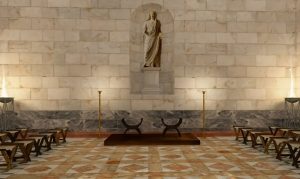
Screen capture from the video about the Roman Curia of Cartagena. Source: regmurcia.com
The riches and most prestigious families of the colony were represented in the senate, who financed works and other expenses in the city and had some rights such as having reserved places at events and celebrations. The functions of the Senate were, among others, decurional decrees, contests and adjudications or appointment of positions. The meetings were presided over by a monumental statue of the Emperor Augustus, dressed in a senatorial toga as the first citizen of Rome and with his head covered by his status as Pontiff Maximus.
The Temple of Isis
Archaeological excavations carried out in the area of the Molinete in 2015 and 2016 resulted in the recovery of another block of Roman Cartagena. This block was occupied by a sanctuary dedicated to the Hellenistic ad Roman gods Isis and Serapis, according to inscriptions dedicated to these deities which were found in the area some years ago. The sanctuary, perhaps associated with the Atrium building, was in uninterrupted use from the last third of the 1st century until the end of the 3rd century, when it ceased to be sacred and was reused in an industrial capacity.
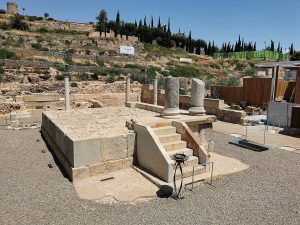
Temple of Isis. By Nanosanchez – Own work, CC BY-SA 4.0.
Isolated from the surroundings and the people outside the cult by an imposing wall, the sanctuary was dominated by a small temple housing a sculpture of the deity, accessed by a staircase and with a facade featuring four Ionic columns. Around the temple was an open courtyard with porticoes on three of it sides, to the rear were three chapels opening out onto the portico related to ceremonies in honor of the divinity and there were also spaces reserved for the priests and the furnishings of the sanctuary.
In the basement of the courtyard in front of the temple were four vaulted cisterns to collect rainwater used in the purification rituals performed in the complex, such as washing of the sculptures.
Between the temple and the chapels there was another oval cistern for storing rainwater.
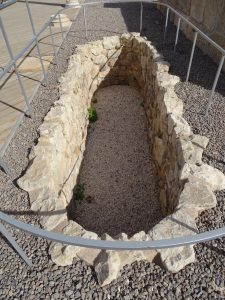
A cistern on the site. Photo by Michel Gybels.
This deposit and other walls were built in the Punic era towards the end of the 3rd century BC and were discarded when the temple was built in the last of the 1st century AD.
The Thermal Baths of the Port
This is a thermal bath complex accessed via a substantial porticoed courtyard or peristyle with a central open-air space paved with bricks arranged in a herringbone fashion (opus spicatum). This space served not only as an entrance but also as a meeting and mixing place for the local elites; it was presided over by a statue of a figure carrying a cornucopia of Carrara marble topped with a basket of fruit, in clear allusion to the “pax romana” achieved by Augustus after the end of the civil wars. This horn of plenty is the only element of the sculpture which has been found. A painting representing a hunter was also discovered in the same place.
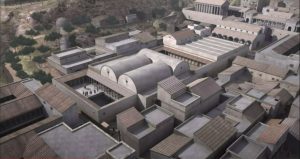
Reconstructed view of the Roman Baths. Source: regmurcia.com
The thermal baths of the port were built in the 1st century AD along a simple linear axis. They feature the typical sequence of cold rooms (frigidaria) which also served as dressing rooms, warm rooms (tepidaria), where the hypocaust or heating system can still be seen, and hot rooms (caldaria) located below the present street. Finally, the complex contains another small warm room and a sauna room. In ancient times the thermal baths were large complexes in which leasure mixed with hygiene, and were used to strenghten social, economic and political bonds.
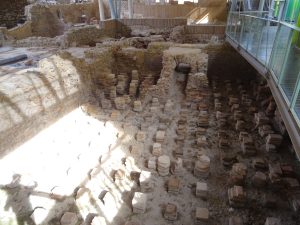
Hypocaust of the Baths. Photo by Michel Gybels.
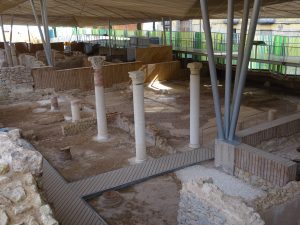
Palestra of the Roman Baths. Photo by Michel Gybels.
The Decumanus
A stretch of the Decumanus Maximus was found in 1968 following the demolition of the Guardia Civil barracks, along with the ovens that heated the tepidarium and caldarium in the thermal baths and the remains of a commercial area consisting of a portico with shops. They were built in the times of the Roman Republic and re-modelled in the 4th century AD, re-using some of the original materials: the clearest example of this is an inscription dedicated to Numisius Laetus, a powerful family in Carthago Nova, which would initially have been in the Forum of the colony and was relocated to this area to form part of the wall of the thermal baths.
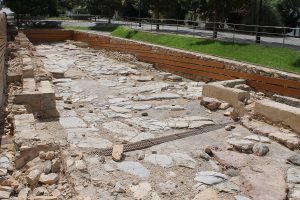
Decumanus Maximus, By VIATOR IMPERI – Cartagena, CC BY-SA 2.0.
The Atrium Building
The Atrium Building was built in the 1st century AD and may have been the seat of a religious group devoted to the celebration of ritual banquets in honour of the gods Isis and Serapis, who were worshipped in the adjoining sanctuary. Over the course of three centuries several alterations led to the original layout being modified, and in its final stage it was converted into a housing complex in which each of the rooms was home to a family. The building was in use until the late 3rd of early 4th century, when a fire destroyed the entire block.
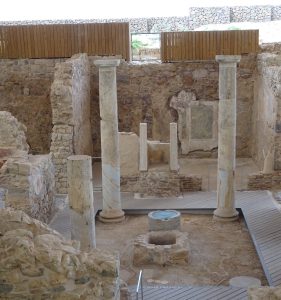
Inner yard of the Atrium Building. Photo taken in situ by Michel Gybels.
Occupying an area of more than 2000 m², the Atrium was organized around a courtyard of columns from which stairs led up to the second floor. Open to the central courtyard were four large rooms in which there are still vestiges of the decorations and where banquets were held, with the diners reclining on couches.
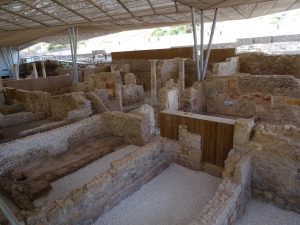
The Atrium Building. Photo taken in situ by Michel Gybels.
The building also contained a hall used for worship, where the mural paintings which mimic the effect of marble still remain, and an altar which stood against the wall of the hall for worship. Service rooms stood on either side of the entrance corridor while there were shops in the exterior facade.
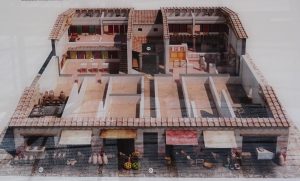
Restitution of the Atrium Building. Photo taken in situ by Michel Gybels.
The most significant findings in the Atrium Building are the paintings of muses and the god Apollo, a painted text commemorating the reform of the building during the time of emperor Elagabalus in the year 218 and the paintings of female masks framed by garlands.
Exploitation of the Site
The first excavations of the Decumanus were carried out by Pedro San Martin Moro, who in 1971 unearthed the first items of value found in the Plaza de los Tres Reyes. Subsequently, in 1997, the Town Hall of Cartagena installed a glass dome over the ruins to preserve them better, and in 2003 Cartagena Puerto de Culturas proposed that the site should be covered and the remains presented in an accessible format for the public.
Work began on the hillside of the Molinete in 1982 with a team of archaeologists led by Miguel Martinez, who continued the excavation of the baths and provided new data leading to a better understanding of the remains of the Decumanus. Since 2008 excavations have continued throughout the side of the hill under the direction of José Miguel Nogera and Maria José Madrid.
All of these excavations have been managed by Cartagena Puerto de Culturas in an ambitious project which was awarded the National Prize for the Restoration and Conservation of Cultural Assets by the Ministry of Culture in the year 2012. The architectural design of the project was undertaken by Nicolas Maruri and Andres Canovas.
The Tour of the Site
- The Molinete Roman Forum Museum: exhibition of more than 300 pieces distributed over three floors from Cartagena to Carthago Nova, Carthago Spartaria and Carthago Nova to Qart Hadast.
- The Colonial Forum and the Curia: neuralgic center that housed the main buildings of every Roman city, among which the Curia or local senate were of particular note.
- Sanctuary of Isis and Serapis: the holy enclosure dedicated to the oriental gods whose images were guarded by the priests in the small temple which occupies the area.
- The Thermal Baths: views of the characteristic different spaces of a thermal complex with cold, warm and hot rooms. The porticoed courtyard which served as access to the thermal baths and in which the herringbone style paving is still in very good condition.
- Decumanus: this area contains more of the facilities of the thermal baths with an oven and ancillary spaces, and it is possible to walk along the Decumanus Maximus, the main road which crossed Carthago Nova from east to west.
- The Atrium Building: a chance to visit the various banqueting rooms, admiring the height of the walls and its ornate decoration.
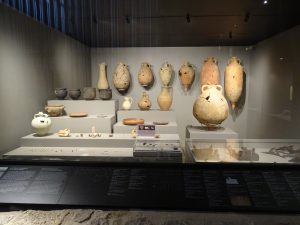
A stand in the Museum with amphorae of various shapes, illustrating commercial links of the ancient Cartagena. Photo by Michel Gybels.
Sources:
- Cartagena Museum brochure “The History and Excavations of the site of the Molinete Roman Forum – Cartagena”.
- The “Carthago Nova” 3D restitution movie: Link
- Carthago Nova : la ville et le territoire. Recherches récentes.
- Cartagena City in the early roman empire era. Generation and analysis of a digital elevation model.
- La pittura romana in Spagna: questioni di metodo e prospettive di ricerca.


